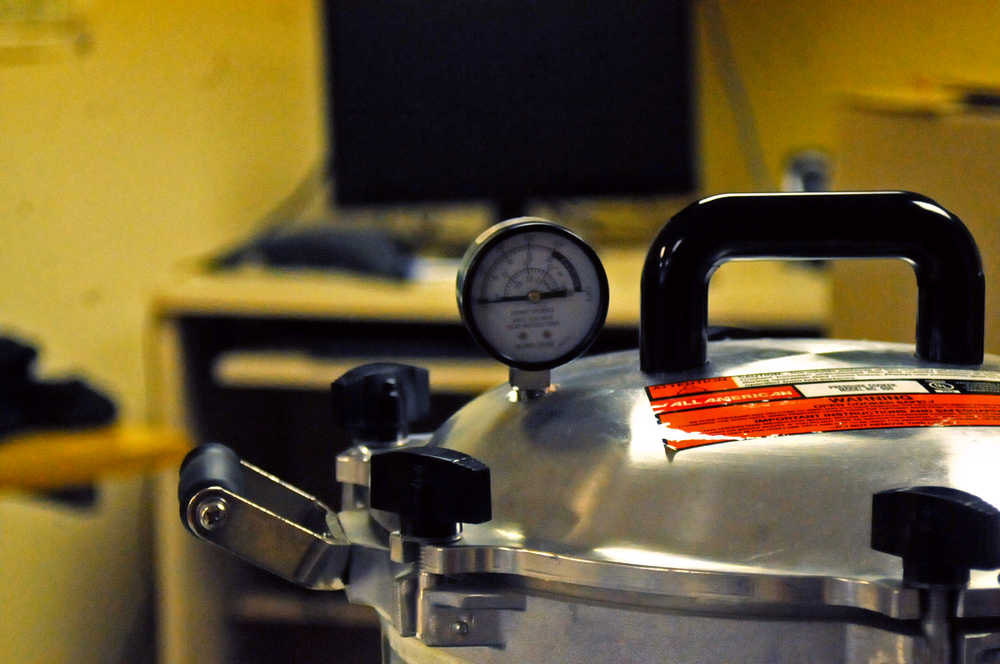Editor’s note: This article has been updated to show that cans in pressure canners should be covered by 2-3 inches of water and should be placed in at room temperature.
The Kenai office of the Cooperative Extension Service checks more canner dial gauges than any office in the state.
Alaskans have long smoked, frozen and canned their summer harvest of wild foods for the long winters, but the Kenai Peninsula sees a huge influx of fishermen every summer seeking to preserve their catch as well as locals who enjoy preparing their own food. Linda Tannehill, the 4-H and Youth Development and Health, Home and Family Agent with the Kenai office, said checking the gauges before getting ready to can foods can be essential.
She cited the example of a man who came in with a canner that had been spitting steam around the lid even though the dial read the proper pressure. When the office tested it, it turned out the needle was stuck and wouldn’t go past the moderate range. He had an older canner that did not have a rubber safety plug, so he could have gotten hurt, she said.
“First it’s about food safety, but it’s also about personal safety,” she said.
Canning salmon is one way to save food beyond when it might get freezer burn or to make it portable for camping trips. Good fish quality starts with care in the field — handling with care to avoid bruising, bleeding it immediately, removing the organs and keeping it cold. Some people can smoked salmon, but because the canning process intensifies the smoked flavor, Tannehill said she recommends a light smoke.
Salmon is a low-acidity food, like wild game, and requires a pressure canner to control the growth of Clostridium botulinum, which grows in anaerobic conditions like cans and causes botulism. The canner should be big enough for the cans to be lifted off the bottom of the pot on a rack but still submerged under at least two to three inches of water.
Fish can be canned in chunks or in whole pieces. Tannehill said she sometimes offers courses showing people how to prepare for salmon canning, beginning with fish preparation and continuing though the process. However, between the preparation and the actual canning, it sometimes take as much as four hours, she said.
When cutting, Tannehill said she uses the jar for measurement to make sure the cuts will fit.
“Regardless of whether it’s filleted fish or one chunk of fish, you want to leave an inch of headspace,” she said.
Once the jars are sealed and the lids tightened, they can be placed in the canner with room-temperature water. Research has shown that fish has to have at least 100 minutes of processing at a minimum pressure of 11 pounds to be safe to eat, Tannehill said.
No water or oil is necessary for salmon, though people can add herbs like basil, salt or garlic if they like without any additional time to fish because fish has to process for so long. For halibut, people can add up to four tablespoons of oil per pint jar to moisten the fish, she said.
After the 100 minutes is up, the canner should be removed from the heat and let to cool, allowing the pressure to drop naturally. Once the pressure has dropped to zero, the jars can be removed and placed on newspaper or a towel. After 12 hours, the lids should be curved downward in the middle and not flex undera touch. If they do, the seal did not take. People should check for nicks on the edge of the jar, and if necessary, change jars and reprocess within 24 hours using the same steps.
Canned salmon can be a quick, easy meal for the end of a day, Tannehill said.
“It really is a convenience food,” she said. “You could open up a jar of canned salmon and have salmon patties in 30 minutes.”
The Cooperative Extension Service offers literature with full instructions, recipes and tips for canning and smoking salmon at its office on Kalifornsky Beach Road, in the same buildling as the Alaska Department of Fish and Game offices.
Reach Elizabeth Earl at elizabeth.earl@peninsulaclarion.com.

